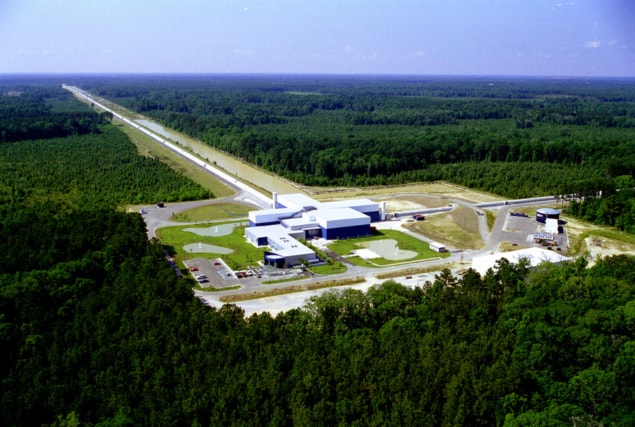LIGO upgrade to allow ‘almost daily’ detection of gravitational waves
15 Feb 2019 Michael Banks
The UK and US have announced a $35m upgrade to the Advanced Laser Interferometer Gravitational-wave Observatory (aLIGO). The improvement will see the twin observatories — located near Hanford, Washington and Livingston, Louisiana in the US – double their sensitivity to gravitational waves. Work on the upgrade will start in 2023 and be complete two years later.
Each LIGO facility works by sending twin laser beams down two 4 km-long tubes – arranged as an L-shape – that are kept under a near-perfect vacuum. The beams are reflected back down the tubes by mirrors precisely positioned at the ends of each arm. As a gravitational wave passes through the observatory, it causes extremely tiny distortions in the distance travelled by each laser beam.
LIGO first turned on 2002 and was upgraded between 2010 and 2015 to improve the facilities’ ability to spot gravitational waves by a factor of 10. Thanks to this $221m upgrade – known as Advanced LIGO, or aLIGO – researchers can detect gravitational waves that originate anywhere within a sphere of about 420 million light-years in radius, centred on the Earth.
That breakthrough was announced in February 2016 when researchers working on aLIGO directly detected gravitational waves for the first time in an event in September 2015 – when aLIGO was being calibrated. The waves were produced from the collision of two black holes of 36 and 29 solar masses, respectively, which merged to form a spinning, 62-solar-mass black hole, some 1.3 billion light-years (410 mpc) away in an event dubbed GW150914. The finding ended the decades-long hunt for these ripples in space–time and marked the beginning of a new era of gravitational-wave astronomy that has since resulted in around 10 gravitational-wave events being detected including from the merger of two neutron stars.
Reducing noise
While aLIGO is set to begin another operating run in the next couple of months, plans are now afoot to boost its sensitivity even further. The US National Science Foundation (NSF) announced today that it will provide $20.4m for a further upgrade to the facility, dubbed aLIGO+. The UK Research and Innovation, meanwhile, will provide a further $14.1m with additional support from the Australian Research Council.
The upgrades will include applying new coatings to the mirrors to reduce thermal noise as well as improvements to the laser system. aLIGO+’s capabilities are expected to probe the origins and evolution of stellar-mass black holes as well as allow precision tests of extreme gravity and enable detailed study of the equation of state of neutron stars.
“This award ensures that LIGO will continue to lead in gravitational wave science for the next decade,” says NSF Director France Córdova. “These detections may reveal secrets from inside supernovae and teach us about extreme physics from the first seconds after the universe’s birth.”
According to David Reitze, executive director of the LIGO Laboratory, the upgrades will see the observatory being able to detect binary black hole collisions on “an almost daily basis”. The improvement will also be made “as standard” to the planned LIGO facility in India, which, if built, is expected to come online in 2025.

physicsworld.com 19/2/2019

Δεν υπάρχουν σχόλια:
Δημοσίευση σχολίου